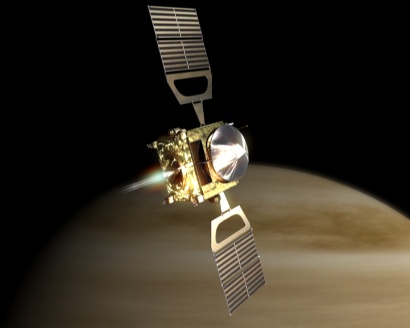Venus Express in orbit
On the morning of Tuesday 11 April, ESA’s Venus Express successfully entered orbit around Earth’s twin planet after its 5 month, 400 million km journey through space. The manoeuvre, the space equivalent of a controlled handbrake turn, went precisely as planned. Over the next month the orbit will be trimmed to its final elliptical orbit, 250 km at its nearest point above the planet’s North pole and high (66,000 km) over its South pole.
Dr Andrew Coates, head of planetary science at UCL’s Mullard Space Science Laboratory and a co-investigator on the mission, says ‘In planetary terms, Venus is our nearest neighbour – but our worst nightmare: an Earth-like planet with a hellish atmosphere’.
Venus and Earth were formed at the same time (4.6 billion years ago) and have similar size and composition, with Venus about 50 million km nearer the Sun. The two planets have evolved quite differently – Venus’ surface is hotter than an oven (460°C) due to a runaway greenhouse effect, it has a carbon dioxide atmosphere with pressure over 90 times Earth’s, sulphuric acid clouds and super-rotating hurricane-force winds, the planet rotates slowly the wrong way round, and it lacks a magnetic field.
‘We are interested in why Venus has evolved so differently, becoming our ‘evil twin’ or ‘twisted sister’’ said Dr Coates.
UCL-MSSL built parts for, tested and led the team for the electron spectrometer (ELS) of the Swedish-led ASPERA-4 instrument. ASPERA-4 will measure the escape of the unprotected Venus atmosphere in the gusty solar wind. At Earth, our magnetic field protects us from the million mile an hour stream of plasma from the Sun – but Venus lacks such magnetic protection.
‘Although we think that Venus’ atmosphere loses about 100 tonnes per day to space, it still has a pressure equivalent to 1km under Earth’s ocean surface. Venus Express will search for signs of active volcanism which could explain this. Our results will help us understand how Venus’ atmosphere evolved’ said Dr Coates.

Venus Express (Image courtesy ESA)
AJC 12 April 2006
Back to the MSSL News page
![]() +44 (0)1483 204100 - Copyright © 1999-2005 UCL
+44 (0)1483 204100 - Copyright © 1999-2005 UCL